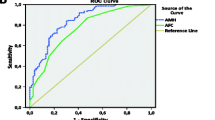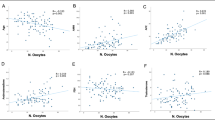Abstract
Purpose
This work investigates the relationship of basal follicle stimulating hormone (FSH) measurements and age to ovarian responsiveness and pregnancy occurrence following controlled ovarian hyperstimulation and intrauterine insemination (COH-IUI).
Method
Basal FSH was measured retrospectively in sera from infertility patients obtained on cycle day 2,3, or 4 of a COH-IUI treatment cycle. Basal FSH was then correlated with COH response parameters and treatment outcome in ovulatory (n =98) and anovulatory (n =33) patients. Clinical data were collected from retrospective chart review. In the ovulatory group, increasing basal FSH was associated with fewer follicles (P = 0.01) and lower peak estradiol (P =0.0001).
Results
No age related effects were detected in the anovulatory group. Also, there were no pregnancies in this group when basal FSH was >22.1 mIU/ml. Increasing age in the ovulatory group was associated with fewer follicles (P=0.0001), lower peak estradiol (P =0.0001), and fewer pregnancies (P =0.04). In the anovulatory group, basal FSH did not correlate with follicle numbers or peak estradiol, although more ampoules of hMG were used for stimulation (P =0.03).
Conclusions
Increasing basal FSH and patient age both correlated inversely with ovarian responsiveness to COH in ovulatory patients. Basal FSH can be used in clinically to identify patients undergoing COH who are unlikely to respond to superovulatory drugs and unlikely to become pregnant.
Similar content being viewed by others
References
Toner JP, Philput CB, Jones GS, Muasher SJ: Basal follicle stimulating hormone level is a better predictor of in vitro fertilization performance than age. Fertil Steril 1991;55:784–791
Muasher SJ, Oehninger S, Simonetti S, Matta J, Ellis LM, Liu HC, Jones GS, Rosenwaks Z: The value of basal and/or stimulated serum gonadotropin levels in the prediction of stimulation response and in vitro fertilization outcome. Fertil Steril 1988;50:298–307
Scott RT, Jr, Hofmann GE, Oehninger S, Muasher SJ: Intercycle variability of day 3 follicle-stimulating hormone levels and its effect on stimulation quality in in vitro fertilization. Fertil Steril 1990;54:297
Scott RT, Toner JP, Muasher SJ, Oehninger S, Robinson S, Rosenwaks Z: Follicle-stimulating hormone levels on cycle day 3 are predictive of in vitro fertilization outcome. Fertil Steril 1989;51:651–654
Tanbo T, Dale PO, Abyholm T, Stokke KT: Folliclestimulating hormone as a prognostic indicator in clomiphene citrate/human menopausal gonadotropin-stimulated cycles for in-vitro fertilization. Hum Reprod 1989;4:647–650
Jacobs SL, Metzger DA, Dodson WC, Haney AF: Effect of age on response to human menopausal gonadotropin stimulation. J Clin Endocrinol Metab 1990;71:1525–1530
Piette C, de Monzon J, Bachelot A, Spira A: In-vitro fertilization: Influence of women's age on pregnancy rates. Hum Reprod 1990;5:56–59
Author information
Authors and Affiliations
Rights and permissions
About this article
Cite this article
Burwinkel, T.H., Buster, J.E., Scoggan, J.L. et al. Basal follicle stimulating hormone (FSH) predicts response to controlled ovarian hyperstimulation (COH)-intrauterine insemination (IUI) therapy. J Assist Reprod Genet 11, 24–27 (1994). https://doi.org/10.1007/BF02213693
Received:
Accepted:
Issue Date:
DOI: https://doi.org/10.1007/BF02213693




